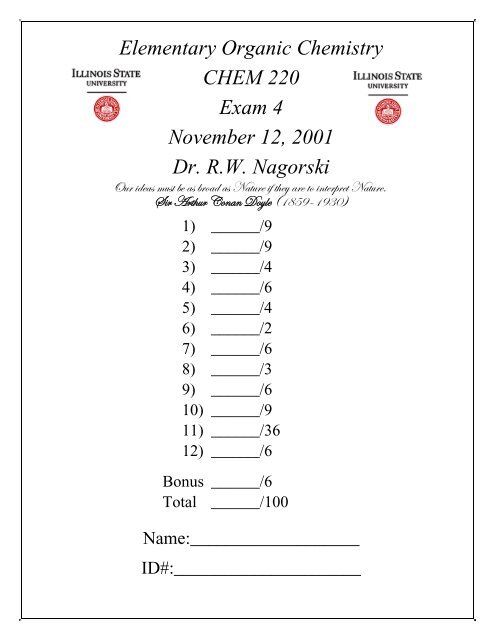Elementary Organic Chemistry CHEM 220 Exam 4 November 12 ...
Elementary Organic Chemistry CHEM 220 Exam 4 November 12 ...
Elementary Organic Chemistry CHEM 220 Exam 4 November 12 ...
- No tags were found...
You also want an ePaper? Increase the reach of your titles
YUMPU automatically turns print PDFs into web optimized ePapers that Google loves.
<strong>Elementary</strong> <strong>Organic</strong> <strong>Chemistry</strong><strong>CHEM</strong> <strong>220</strong><strong>Exam</strong> 4<strong>November</strong> <strong>12</strong>, 2001Dr. R.W. NagorskibâÜ |wxtá Åâáà ux tá uÜÉtw tá atàâÜx |y à{xç tÜx àÉ |ÇàxÜÑÜxà atàâÜxAf|Ü TÜà{âÜ VÉÇtÇ WÉçÄx ;DKHL„DLFC
<strong>CHEM</strong> <strong>220</strong> – <strong>Exam</strong> 4Page 2<strong>November</strong> <strong>12</strong>, 2001Part A: Nomenclature1) Give the IUPAC name for the structures shown below. (9 points)a)b)Ic)NH 22) Given the IUPAC names below; draw the structure for each compound. (9 points)a)p-amino methyl benzeneb)4-cyclohexyl-2-pentanaminec)N,N-dimethyl-2-propanamine
<strong>CHEM</strong> <strong>220</strong> – <strong>Exam</strong> 4Page 4<strong>November</strong> <strong>12</strong>, 20015) Draw a resonance hybrid for each set of resonance structures and circle the most stable resonance structure. (4points)a)b)O O-O-6) Why are tertiary radicals more stable than primary radicals? (2 points)
<strong>CHEM</strong> <strong>220</strong> – <strong>Exam</strong> 4Page 5<strong>November</strong> <strong>12</strong>, 2001Name:_______________________7) Rank the following alcohols from most acidic (1) to least acidic (5). (6 points)OHOHOHOHO 2 NNO 2NO 2O 2 NOHNO 2NO 28) Why is the nitrogen in compound A a moderately strong ortho/para director while the nitrogen in compound B is astrong ortho/para director. (3 points)HNOHNAB9) Indicate the most likely position of electrophilic aromatic substitution for the compounds below? (6 points)CH 3IOCH 3OCH 3O
<strong>CHEM</strong> <strong>220</strong> – <strong>Exam</strong> 4Page 6<strong>November</strong> <strong>12</strong>, 2001Part C: Reaction Mechanisms10) Give the mechanism for the reaction shown below, showing all intermediates and the movement of electrons usingarrows. (9 points)HH OH HO AlCl 3HCH 3++ HClCl CHH H3H HHH
<strong>CHEM</strong> <strong>220</strong> – <strong>Exam</strong> 4Page 7<strong>November</strong> <strong>12</strong>, 2001Name:_______________________11) For the radical halogenation reaction shown below, name the three steps of the reaction and give one example ofeach step.Br 2hνBr+ HBr
<strong>CHEM</strong> <strong>220</strong> – <strong>Exam</strong> 4Page 8<strong>November</strong> <strong>12</strong>, 2001Part D: Reactions<strong>12</strong>) What is the major product or products for each of the following reactions shown below? When more than oneproduct is expected, circle the product that will predominate. (36 points)a)b)c)d)e)OHBrHO -Cl CH 3 O -Δ1) B 2 H 62) H 2 O 2OCH 3HIKMnO 4H 2f)HClg)OCH 3 MgBrh)Pti)OH H 3 PO 4
<strong>CHEM</strong> <strong>220</strong> - <strong>Exam</strong> 4Page 9<strong>November</strong> <strong>12</strong>, 2001Name:_______________________Part E: Definitions13) Give a brief definition for each of the following words. (6 points)a) Resonance:b) Aromatic Compound:Bonus Questions: (Bonus questions are graded correct or incorrect. No partial credit is given)What are the bond angles of a sp 2 -hybridized carbon? (3 points)What is the equation that relates pK a and pK b ? (3 points)
















